Project Log: Saturday, July 7, 2012
I spent part of the morning on some final mast paint
preparations, moving the masts across the yard away from
the building, masking the remaining hardware, and
preparing the paint and other materials. It still
looked like a good weather window coming up, and I was
looking forward to completing this job. At the end
of the day, I covered both spars with polyethylene
tubing to help keep dew from settling on them, as my
first step before painting would be to sand once more,
and I wanted to get started early.
From storage, I dug out the spreader tube from the
mizzen mast and cleaned it up and sanded it so I could
paint that (along with the new mainmast spreaders) at
the same time. |

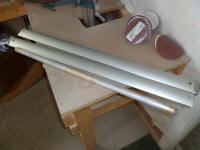 |
Back up in the boat, I started work on the final hoses
required for the engine heat exchanger's connection to
the water heater and coolant tank. At first
glance, this was a simple chore, but as I prepared to
lead a hose from the engine room to the remote coolant
tank above, I realized that I had better figure out some
other hose runs first--most notably the fuel fill hose
that had to lead from the same compartment back to the
aft centerline fuel tank.
Since the fuel fill hose was larger and stiffer, places
where I could run it through this increasingly
complicated little area were limited. The best
place was inboard of the water heater, but to run it
there I needed to use a hole saw to cut partially
through the plywood support for the water heater, as
this was limiting the space available for the hose.
Fortunately, this went easily, and after installing some
chafe gear on the fuel hose I led it through and
connected it to the tank, leaving the other end long
pending final installation of the fuel fill panel in the
side of the pilothouse. |
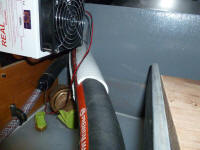
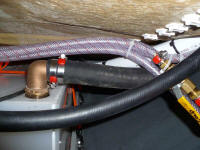 |
While I was at it, I led the vent line for this tank
through the same general area, securing it along the
way as needed and leaving the forward end long for now. |
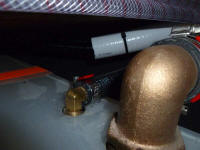
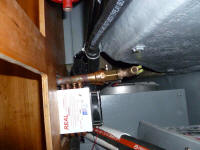 |
Now I could run the two 5/8" hoses required for the
engine's coolant tank. The first hose led from the
bottom of the slim green heat exchanger (part of the
heating system), where I'd previously installed a hose
stub and valve, and then the return line from the
coolant tank ran back to the engine itself, to the
second of two fittings installed for this purpose.
|

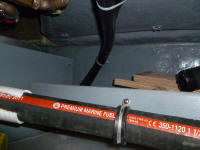
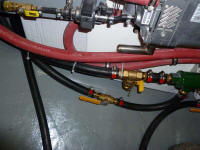
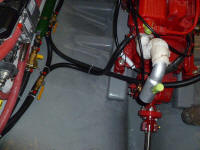
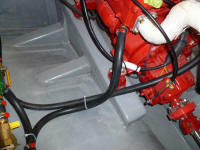 |
Finally, I pulled the air intake hose for the diesel
boiler out of its box and checked to see how I could
lead it to the connection on the boiler. I found I
could lead it behind the support where I installed the
fuel filter and valve for the boiler, and this meant the
intake wouldn't interfere with the rubber hose leading
the boiler nearby. I'd been waiting to install a
service valve in this length of hose till I could
determine it wouldn't interfere with the air intake, but
with that question resolved I cut the hose and installed
an inline shutoff valve, which I secured just above the
fuel lines below. This valve, along with another
one in the system on the other side of the circulation
pump, would allow the boiler or pump to be removed from
the system if needed without having to drain the entire
system. |
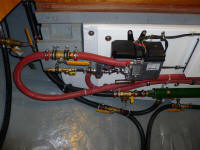
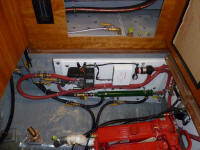 |
| |
Total Time Today: 5.75 hours
|
<
Previous | Next > |
|
|














